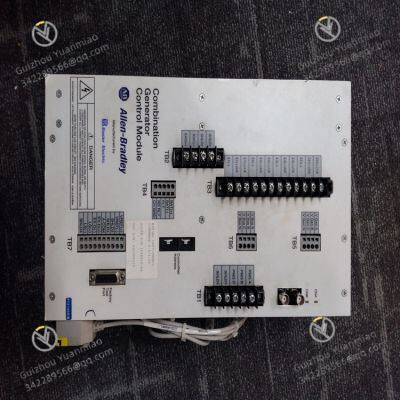Product Description
The A-B (Allen-Bradley, a brand under Rockwell Automation) 1407-CGCM is an integrated control module specifically designed for small and medium-sized generators (especially diesel/gas generators). It focuses on meeting the integrated needs of generators for "start/stop control, speed regulation, voltage regulation, and safety protection". Its core advantage lies in integrating the functions of traditionally decentralized "speed governors, voltage regulators, and controllers" into a single module, which significantly simplifies the hardware architecture of the generator control system, reduces wiring complexity and fault risks. It is widely used in backup power supplies (e.g., data center and hospital emergency generators), distributed generation (e.g., biogas power generation, small natural gas power plants), and mobile power generation (e.g., vehicle-mounted/marine generators) scenarios.
I. Basic Information and Core Positioning1. Interpretation of Model and Product Identification
Allen-Bradley control module models follow the logic of "product series + function type + configuration parameters". The specific meaning of the 1407-CGCM identification is as follows:
1407: Product series prefix, representing A-B’s "small generator control module series". This series features a compact, low-cost design, suitable for small and medium-sized generators with power ≤ 1000kW, distinguishing it from redundant control platforms for large power plants (e.g., A-B PowerFlex series).
CGCM: Function code, standing for "Combination Generator Control Module". It clearly defines its core positioning of "integrated speed regulation, voltage regulation, and logic control", eliminating the need for additional independent speed governors or voltage regulators.
2. Core Application Scenarios
As a "one-stop control center" for generators, the 1407-CGCM is mainly suitable for the following scenarios and equipment:
Emergency backup power supplies: Emergency diesel generators in data centers, hospitals, and high-rise buildings, enabling fully unattended control of the entire process from "mains power failure → automatic startup → speed stabilization → voltage establishment → grid-connected power supply".
Distributed generation systems: Small biogas generators and natural gas distributed power plants. The module precisely controls the power generation frequency (50/60Hz) and output voltage (380V/400V) to ensure power quality meets the requirements of grid connection or local loads.
Mobile power generation equipment: Vehicle-mounted generators (e.g., engineering emergency vehicles) and marine auxiliary generators. Their compact size and wide-temperature design adapt to space constraints and environmental fluctuations in mobile scenarios.
Multi-machine parallel control: Supports "masterless parallel connection" of 2-4 generators of the same model to achieve uniform load distribution (e.g., parallel connection of factory backup generators to meet high-power demands), without the need for additional parallel controllers.

II. Key Technical Parameters1. Core Control Performance Parameters
2. Electrical and Environmental Parameters
III. Core Functions and Technical Characteristics1. Integrated Control Functions (Speed Regulation + Voltage Regulation + Logic)
It breaks the traditional decentralized control mode of "speed governor + voltage regulator + PLC" for generators, achieving highly integrated functions:
Speed closed-loop control: Real-time collects the generator speed signal through a speed sensor, compares it with the set speed, and outputs a PWM drive signal to control the fuel injection valve (diesel generator) or throttle (gas generator), dynamically adjusting fuel/gas supply to stabilize the speed (e.g., 50Hz generators stabilized at 1500 RPM). It supports automatic switching between "idle speed - rated speed" (idle warm-up during startup, and speed increase to rated speed after load connection) to reduce engine wear.
Voltage closed-loop control: Controls the excitation current output by the excitation regulator by comparing the generator output voltage sampling signal (PT transformer input) with the set voltage, adjusting the generator stator voltage. It has built-in "voltage soft start" function (voltage rises slowly to the rated value during startup to avoid impact loads) and "load compensation" function (adjusts excitation in advance according to load current changes to reduce voltage drop).
Logic control and process automation: Built-in full-condition control logic for generators, supporting multiple operation modes:
Automatic mode: After mains power failure, the generator starts automatically with a delay of 0-10s. After speed stabilization, voltage is established, and the grid-connected contactor closes automatically when grid connection conditions are met. After mains power recovery, the load is automatically unloaded and the generator shuts down.
Manual mode: Manually controls startup/shutdown and speed/voltage fine-tuning via local buttons or remote commands.
Test mode: Supports "no-load startup" (only the engine runs without voltage output) for regular maintenance testing.
2. Comprehensive Safety Protection Functions
A variety of hardware and software protection mechanisms are built-in for key risk points during generator operation:
Speed protection:
Overspeed protection: When the speed exceeds 115% of the rated value, fuel/gas supply is immediately cut off to trigger emergency shutdown.
Underspeed protection: If the speed is lower than 80% of the rated value for 10 consecutive seconds after startup, it is determined as a startup failure, the startup process stops, and an alarm is triggered.
Voltage protection:
Overvoltage protection: When the output voltage exceeds 115% of the rated value, the excitation output is cut off to avoid damage to load equipment.
Undervoltage protection: When the voltage is lower than 80% of the rated value for 5 consecutive seconds, an alarm is triggered and an attempt is made to re-establish the voltage; if failed, the generator shuts down.
Other protections:
Overcurrent protection: Detects the output current through an external current transformer (CT). When the current exceeds 120% of the rated current, an overload alarm is triggered and load increase is limited.
Fault memory: Can store the latest 10 fault records (including fault type, occurrence time, and speed/voltage/current data at the time of the fault), which can be queried via the communication interface or local buttons to facilitate fault traceability.
3. Convenient Configuration and Monitoring Capabilities
Local operation and display: Equipped with 4 function buttons (setting, confirmation, increase/decrease, reset) and a 2-digit LED nixie tube + indicator lights. Key parameters such as rated speed, rated voltage, and startup delay time can be set on-site. Real-time display of current speed, voltage, and operation status (e.g., "standby", "running", "fault") allows basic debugging without connecting to a computer.
Remote monitoring and communication: Connects to a touchscreen (e.g., A-B PanelView series) or upper-level computer system via the RS-485 interface (Modbus RTU protocol) to realize:
Real-time monitoring: Remotely view operating parameters such as speed, voltage, current, and load rate.
Parameter configuration: Remotely modify control parameters (e.g., speed PID parameters, protection thresholds).
Control commands: Remotely send control commands such as startup, shutdown, and grid connection.
Data upload: Upload operating data and fault records to the SCADA system to realize historical data traceability and report generation.
Parameter self-tuning: Supports self-tuning of speed PID and voltage PID parameters. During initial operation, the module automatically adjusts the PID coefficients according to the generator load characteristics, avoiding the complexity of manual debugging and shortening the debugging cycle (self-tuning process takes approximately 5-10 minutes).

IV. Compatible Equipment and Maintenance Guidelines1. Compatible Generator Types and Accessories
2. Installation and Maintenance Guidelines


ABB NU8976A99 HIER466665R0099 HIEE320693R0001 controller module
GE UR8FH UR-8FH universal relay module
GE PQMII-T20-C-A Power Quality Meter
HONEYWELL TK-PRR021 51309288-275 REDUNDANCY MODULE
Honeywell TK-PRS021 51404305-275 Control Processor Module
ABB 500CPU05 1MRB150081R1/E CPU Module
ABB 500CIM05 1MRB150077R1/B Communication Module
ABB 500MBA02 1MRB200053/M Controller Module
ABB 500SCM01 1MRB150004R0001 Coupler Module
ABB 500AIM02 1MRB150022R001 Controller Module
ABB 500BIM01 1MRB150024R00026 Bus Interface Module
TRICONEX 9771 7400195-210 3000656-210 External Control Board
 yezi
Hi there! Welcome to my shop. Let me know if you have any questions.
yezi
Hi there! Welcome to my shop. Let me know if you have any questions.




